All the clear explanations, helpful tips, and essential links you need to complete a new character quickly and stress free.
Hey there!
Welcome and well met!
If you are reading this, I imagine you are preparing to fill out a D&D character sheet. But this time, you're all on your own.
No DM, no veteran player, no character creation app. Just you.
You were welcomed into the TTRPG community, have partaken in adventures both hilarious and harrowing, delved through dungeons, drawn swords against dragons...
But you were handed characters so heavily helped that you're starting to feel like your hero isn't entirely your own. You can feel the walls closing in around your creativity.
Today, we're handing you a sledge hammer. Because you don't want someone (or some app) to do it for you. Your creativity will thrive, unrestricted.
Like a fledgling bird, you are on the edge of the nest, ready to spread your wings and glide into the world of character creation!
But then you take a look at the blank pages. All those fields, all that addition and subtraction... and, gosh, there's three pages! You stall, realizing that you might need a little help navigating.
And that is exactly what we're here for: to give you the lift you need to let your creativity soar.
This post is a step-by-step walkthrough of the fifth edition Dungeons and Dragons character sheet. It offers clear explanations, helpful links, and directions, all for the purpose of making this process as simple as possible.
So fear not, for filling in a character sheet is far easier than it looks. Even the math is simple!
There are several character sheet designs, but we will be using the standard, three-page, D&D 5e character sheet, which can be downloaded for free here.
By the end, not only will you experience a deep, satisfying sense of achievement, but you'll have a beloved character all your own.
So without further adieu, let's get started!
Table of Contents
The Big Enchiladas
- Class and Race
- Background
Math and Numbers
- Ability Scores
- Ability Modifiers
- Proficiency Bonus
- Saving Throws
- Skills
- Passive Perception
- Armor Class
- Initiative
- Speed
- Hit Dice
- Hit Points
- Spellcasting Class
- Spell Save DC and Spellcasting Ability Modifier
- Spell Attack Bonus
- Carrying Capacity
- Starting Gold
- Weapon Proficiencies
- Attack Bonus and Damage Bonus
Role-Playing
- Languages and Equipment
- Features and Traits
- Spells and Spell Slots
- The Second Page
- Alignment
Conclusion
The Big Enchiladas
Class and Race
Nothing will impact your character more than your class and race choice. These choices will affect a significant portion of the information you add to your character sheet. Different classes and races will have different benefits, skills, proficiencies, and more.
Synergy (or a complete lack thereof) between the two is also important. Kind of hard to play a bull-headed, meat shield of a Barbarian as a 3'4'', 50lb gnome. Unless that's exactly the kind of chaos you're looking for!
There are many classes and races to choose from in D&D. What you choose will depend on what kind of character you most want to play.
Don't have a class and race selected yet? You can find all D&D classes and races with the provided links.
And don't forget about Tasha's! Tasha's Cauldron of Everything offers the option of flexible race stats. Just take a look at pages 8 - 9.
Once you make your choices, be sure to keep the tabs open. We'll reference them often.
Background
A character Background is meant to act as one important aspect or full reflection of the life your character has led before the beginning of the campaign.
Your choice of Background impacts the personality and backstory of your chosen character.
Thus, you'll want to pair your Background with the world your character is a part of and, most importantly, your character's personality traits.
(Having some trouble deciding what to put here? The Player's Handbook has a handy list of Traits, Ideals, Bonds, and Flaws to choose from! This can also be found with the provided links. If none of these strike your fancy, there is a wealth of options in the numerous D&D character/character trait generators such as this one here. When all else fails, character creation websites meant to help novelists create meaningful characters can also be a tremendous help here).
There are dozens of different D&D 5e character backgrounds and all of them can be located using the provided link. Again, you'll want to keep the selected tab open. You'll be referencing this often as you fill out your D&D character sheet.
Prefer a PDF?
Math and Numbers
Ability Scores
Now that we have these vital pieces of information ready, let's jump right in and get all of the math out of the way first!
Your abilities determine how skillfully your character can do things.
They are as follows:
Strength : Your physical capabilities: lifting, jumping, climbing, etc.
Dexterity : Your speed, agility, reaction time, and capacity for stealth.
Constitution : How hardy and healthy you are. I.E. how many hits you can take before you go down.
Intelligence : Your book smarts.
Wisdom : Your street smarts.
Charisma : Your level of charm: how captivating you are, how trustworthy you are/seem, and how good you are at threatening and deceiving others.
An Ability Score is the number you assign to each Ability.
These scores affect nearly every number on your D&D character sheet.
There are several ways to determine a character's Ability Scores, but the three most common are:
1. Select the standard array of pre-determined Ability Scores: 15, 14, 13, 12, 10, and 8.
2. Use the point-buy system.
3. Roll for it.
If you choose to roll for it, you'll want at least 4d6 (four six-sided dice). If that option is unavailable to you, you can always roll a single d6 four times or use an online dice roller.
Roll all d6, drop the lowest number, and add the remaining 3 numbers together.
Make a note of the total on a slip of paper or in your phone.
Repeat this process five more times for a total of six numbers.
Whatever method you choose, the result will always be six numbers.
Apply one number to one Ability of your choosing until all six Abilities have a number.
(Rolled for it and got unlucky? Be sure to discuss this method with your DM. Some DMs will let you try this more than once. My DM is generous and allows his players up to four attempts... mostly because my table has absolutely atrocious luck when it comes to rolling Ability Scores).
When creating a D&D character that can effectively adventure, it's important to give your highest ability scores to the abilities your selected class depends on. Different D&D classes will rely on different Abilities to cast spells, perform certain tasks, and so on and so forth. Artificers, for example, rely on Intelligence while Barbarians rely on Strength. Reference your class selection to determine what Ability you should give your highest score.
Moreover, some races and backgrounds will give your character Ability Score increases. If you select a human, for example, you get a +1 to every Ability Score.
If your DM allows for the use of additional features—commonly known as feats—this can affect your Ability Scores as well. Selecting the Telekinetic feat, for example, gives your character a +1 to Intelligence, Wisdom, or Charisma. These bonuses stack!
Ability Modifiers
Your Ability Modifiers are dependent on your Ability Scores.
I.E. the Abilities you just rolled above. Each Ability Modifier is calculated as follows:
Ability Score = Ability Modifier
2 or 3 = -4
4 or 5 = -3
6 or 7 = -2
8 or 9 = -1
10 or 11 = 0
12 or 13 = +1
14 or 15 = +2
16 or 17 = +3
18 or 19 = +4
20 or 21 = +5
If your Ability Score is 18, you have a +4 Ability Modifier. If your Ability Score is 9, you have a -1 Ability Modifier.
Easy!
Missing Something?
Proficiency Bonus
A Proficiency Bonus, also known as a Proficiency Modifier, is a little bonus you add to actions your character is especially good at.
Proficiency Bonus is determined by level.
Levels 1 - 4 = +2
Levels 5 - 8 = +3
Levels 9 - 12 = +4
Levels 13 - 16 = +5
Levels 17 - 20 = +6
Saving Throws
A Saving Throw is a check you must pass to prevent an ongoing event from negatively impacting your character.
Is the ground beneath you starting to crumble and fall? Make a Dexterity Saving Throw to see if you can leap away before you fall with it. Are you standing within the affect range of the spell Hypnotic Pattern? Make a Wisdom Saving Throw to see if you can resist its power.
But before you can determine the scores for your Saving Throws, you must first determine what two Saving Throws you are proficient in.
Saving Throw proficiency is determined by your class.
Barbarians, for example, are proficient in Strength and Constitution Saving Throws.
Once you have discovered what two Saving Throws you have proficiency in, fill in the little bubbles beside each associated Throw.
Now that you have your proficiencies, it's time to calculate your scores.
For Saving Throws you are proficient in, add your Proficiency Bonus to the associated Ability Modifier.
Say, for example, you're starting at level 1 and your Ability Modifier for Dexterity is +3. Add your +2 Proficiency Bonus and you'll get a Dexterity Saving Throw of +5.
For the Saving Throws you are not proficient in, the score will be the same as your Ability Modifier.
So, if your Charisma Ability Modifier is +2, your Charisma Saving Throw will be the same.
Skills
Like with Saving Throws, you must first determine what Skills you are proficient in before you can assign each one a score.
Proficiency in Skill is affected by race, class, and background choices.
If you play with additional feats, this can affect your Skill proficiencies as well.
Each Skill is associated with a specific Ability as follows:
Acrobatics = Dexterity
Animal Handling = Wisdom
Arcana = Intelligence
Athletics = Strength
Deception = Charisma
History = Intelligence
Insight = Intelligence
Intimidation = Charisma
Investigation = Intelligence
Medicine = Wisdom
Nature = Intelligence
Perception = Intelligence
Performance = Charisma
Persuasion = Charisma
Religion = Intelligence
Sleight of Hand = Dexterity
Stealth = Dexterity
Survival = Wisdom
Raring to Go?
Click here to download the official fifth edition character sheet!
Luckily, your character sheet has the shorthand for each Ability written directly beside each associated Skill.
For Skills you are proficient in, add your Proficiency Bonus to the associated Ability Modifier, just as you did when calculating your Saving Throws.
For example, let's say you're proficient in Performance. Performance is a Charisma Skill. Your Charisma Modifier is +4. So you would add your +2 Proficiency Bonus to your +4 Charisma Modifier for a Performance Skill of +6.
For Skills you are not proficient in, simply transfer the associated Ability Modifier over to the related Skill.
If you were not proficient in Performance, for example, your Performance Skill would simply be +4, NO Proficiency Bonus added.
Passive Perception
Passive Perception, also known as Passive Wisdom, affects your character's ability to take in what's happening around them without active observation. In essence, how much you can pick up on from just the corners of your eyes and subtle auditory/tactile clues.
Your DM may use your Passive Perception to see if you notice the arrant baseball headed straight for your head or the tiny draft leaking out from the secret passageway hidden behind the fireplace.
Calculating your Passive Perception starts with the number 10.
Take a look at the Skills you just filled in. There's a Skill there called Perception.
Take that number and add it to 10.
If the number is negative, subtract it from 10.
The result is your Passive Perception.
Armor Class
Armor Class, almost always abbreviated as AC, depends on the armor your character is wearing and the equipment (typically shields) said character is carrying.
If your character is wearing armor, give the set in question a quick search. Your selection will either give you a hard number (chain mail, for example, grants the wearer a 16 AC) or it will give you some math to do: a number to add to your Dexterity Modifier (leather armor is an 11 + your Dexterity Modifier).
If you are not wearing any armor, your AC is simply 10 + your Dexterity Modifier.
(Alright, but hold on. Where do you get your armor from in the first place? How do you know if you're wearing chain mail or leather or plate... or any armor at all?! Click here to see the answer).
Initiative
Determining initiative (in essence, your character's reaction time) is easy.
Your Dexterity Modifier is your Initiative.
So if your Dexterity Modifier is +3, so too is your Initiative.
Unless you like a challenge, you don't want to have a negative number here. Initiative helps decide when you get to take your turn during combat.
Speed
Again, this one's easy.
Your Speed is determined by your race.
If you choose a winged creature like an Aarakocra or a water creature like a Triton, you may also have a separate flying or swimming speed.
Not playing a Triton? In general, your swimming speed is about half your walking speed (I.E. the number you just filled in above).
Hit Dice
Hit Dice are not HP. Hit Dice are simply the tools with which you will calculate your HP. Hit Dice are additionally involved in leveling up.
The number of hit dice you have is equal to your level.
The type of hit dice you have is determined by your class.
Ready to get Started?
Hit Points
Here's our HP!
To calculate your D&D character's HP, take the maximum value of your Hit Dice and add it to your Constitution Modifier.
When your character levels up, you will roll one Hit Die and add the number rolled to your Constitution Modifier. You then take this new number and add it to your current, total HP Maximum.
So let's say you have 18 HP at level 1. Your Hit Die is a d8 and your Constitution Modifier is a +2. When you level up, you roll your hit die: it lands on a 5. Add 2 and 5 together for a total of 7. Then add 7 to your original 18 HP for a new total of 25 HP.
Your total HP maximum should go on the small line labeled "Hit Point Maximum."
The space below is for your current HP. That is, your HP after you take damage.
Spellcasting Class
Skip past the second page and land on the third to find the field for Spellcasting Class.
This field is another easy one.
Your Spellcasting Class is the same as your class choice.
Spell Save DC and Spellcasting Ability
Though you can calculate a Spell Save DC for any class, this number will be most important to spellcasters such as Wizards and Sorcerers.
Your Spell Save DC is 8 + your Proficiency Bonus + your Spellcasting Ability Modifier.
What is a Spellcasting Ability Modifier?
Any spell you cast in D&D is dependent on a single Ability Score. This is your Spellcasting Ability.
What Spellcasting Ability you have is dependent on your class. Wizards, for example, use Intelligence as their Spellcasting Ability. Therefore, a Wizard's Spellcasting Ability Modifier is their Intelligence Modifier.
So, let's say you're playing a Wizard and your Intelligence Ability Modifier is +5. Your Spell Save DC is then 8 + 2 (Proficiency Bonus) + 5 (Intelligence Ability Modifier).
Spell Attack Bonus
This is your Spellcasting Ability Modifier + your Proficiency Bonus
More than once have I made the mistake of using my Spell Save DC instead of my Spellcasting Ability Modifier. Don't be like me a double check your numbers!
Carrying Capacity
In most campaigns, you won't be required to keep track of this number. It is often silly, anyway, and most us will end up acquiring a Bag of Holding to avoid weight restrictions and the issue of "where in the world did you just pull that sword from?" Thusly, there isn't a field on the D&D 5e character sheet for this stat. However, there are some campaigns, situations, and DMs that will call for it, so we haven't left it off the list!
For medium- and small-sized characters (your character's size is determined by said character's race):
Your Carrying Capacity is your Strength Ability Score (for once, not the Modifier) multiplied by 15.
You can push, drag, and lift (not carry around) objects that are twice your Carrying Capacity. That is, your Strength Score multiplied by 30.
Most races in D&D will either be small or medium (even a Goliath, for example, is a medium creature), but if you happen to be playing something smaller or larger, here's how you can calculate your Carrying Capacity:
- For tiny creatures, multiply your Strength Score by 15 and then halve the result.
- For large creatures, multiple your Strength Score by 15 and then double the result.
While pushing or dragging anything that is heavier than your maximum Carrying Capacity, you have a -5 to your speed. If it's just below, then hey, you take no penalties! Feel free to push that boulder out of the way at a speed of roughly 30ft per every-six-seconds!
Told you it was silly.
Only Have the First Page?
Starting Gold
Your Starting Gold is recorded in the small fields labeled CP, SP, EP, GP, and PP. This stands for copper pieces, silver pieces, electrum pieces, gold pieces, and platinum pieces, respectively. Gold is what you'll be starting with.
There are a variety of ways to determine your Starting Gold and your DM likely has a preference. Generally, however, there are two common ways.
The first is directly tied to how you obtain your starting equipment. With this method, you roll a class-dependent type and amount of dice and then multiply the result by 10. You then use this wealth to purchase your starting equipment. Anything leftover is your Starting Gold.
The most common method, however, involves using predetermined, class-specific starting equipment (to put it simply, your class therefore determines your options for weaponry and armor).
Your Starting Gold is then determined by your background choice.
Your DM may choose to give you a little less or a little extra depending on the lifestyle of your character. My character, for example, has had a business up and running for the past eight years, so my DM awarded him a little extra cash.
(Jumped here from the Armor Class section? Click here to jump back).
Weapon Proficiencies
Both your starting weapons and your weapon proficiencies are determined by your class, race, features, and/or background choice.
Take a look at the "Attacks and Spellcasting" field.
It is here that you can make note of the weapons you carry. Pay special attention to those with which you have Proficiency. This will be important in the next section.
If need be, you can also use the Attacks and Spellcasting field to make note of your unarmed strike.
An unarmed strike is any hit you make with your bare fists, feet, head, etc. Contrary to expectations, this isn't determined by your hit dice. It's 1 + your Strength Modifier. This rule is a little different for Monks. Monks have class-specific bonuses to their unarmed strikes.
Attack Bonus and Damage Bonus
When you select a weapon, you're going to want to pay attention to its type (ranged, melee, martial, etc.).
Depending on the weapon's type (and unless stated otherwise), you get to add your Strength or Dexterity Ability Modifier to your attack roll.
This is determined as follows:
Melee and thrown weapons: Strength Modifier
Ranged Weapons: Dexterity Modifier
Finesse Weapons: Your choice of Strength or Dexterity
But that's not all you get to add. If the weapon's type is among your weapon proficiencies, you also get to add your Proficiency Bonus to your attack rolls.
Add these bonuses to the "ATK Bonus" field.
If you successfully hit whatever you're attacking, you also get to add your Strength or Dexterity modifier to your damage roll. You do not, however, add your Proficiency Bonus to damage rolls.
Role-Playing
Languages and Equipment
Huzzah, you've made it all the way through the math and numbers portion! The rest of your sheet is easy!
The languages your character speaks is affected by your race and background choice.
However, what languages you choose depends on the character you have created and the life they have led.
Are you a warlock with the capacity to speak with demons? Abyssal is the language for you! Are you an elven druid that's made close friends out of the local fey? Looks like you can speak Sylvan! But if you want to speak with the majority of those around you, don't ignore Common!
Character Sheet Starting to Feel Less Like a Foreign Language?
Click here to begin filling out a sheet of your own!
The rest of your equipment—this including more than just weapons—is dependent on your class and background choice.
This equipment can appear anywhere from significant to mundane, but with a little creativity anything you carry can offer benefits.
For example, my party's Warforged obtained "a small piece of jewelry worth 10gp" for his choice of the Far Traveler background. He could have elected to sell this off for a little extra cash, but instead decided to transform this seemingly-mundane object into the last remaining keepsake of a lost friend.
If you don't have enough room in the equipment field for all the stuff you're carrying, you can always use the "Treasure" field on the second page as overflow.
Features and Traits
This field is for special, well, features and traits you get as a result of your race and class choice.
For example, a Half-Orc has "Relentless Endurance" while Elves and Half-Elves have "Fey Ancestry." You will gain more of these features and traits as you level up.
Mark these down in the "Features & Traits" box on the first page of your character sheet. When that box fills up, there's an "Additional Features & Traits" field on the second page.
Spells and Spell Slots
For all you spellcasters out there, it's time to choose your spells!
The list of spells you have to choose from is dependent on your class.
How many spells you can choose is dependent on your class and level.
The number of spells you can choose at level 1 is equal to the number of Spell Slots you have.
Both your spells and your Spell Slots can be tracked on the third page of your character sheet.
Actually, spells make up basically ALL of the 3rd page of the D&D character sheet. Fill out yours here.
You are going to want to keep track of your Spell Slots.
My current D&D group is comprised of people who have only ever played one prior campaign and a first-time DM that has spent more time with D&D 3.5 than 5e. For several sessions, all of us believed that once you cast a spell, the spell itself is expended. This left all of us quite perplexed: what, then, did anybody need Spell Slot trackers for?
Turns out, we were all very wrong.
When you cast a spell, it is the Spell Slot, not the spell itself, that is expended.
If you have four level 1 spell slots, you can cast four, unique level 1 spells; the same level 1 spell four times over; and everything in-between! Suddenly, our sessions got a lot more interesting.
You'll notice that there isn't a field for jotting down what each spell does. There are several ways to combat this problem:
1. Make and print additional pages.
2. Search the internet or through the Player's Handbook for the spells in question.
3. Purchase a deck of class-specific spell cards.
4. Purchase spell card PDF packs (blank or pre-filled)
Or, if you've got the time and you're looking to save on money:
5. Hand make your own spell cards.
Personally, I love the convenience of physical spell cards and ended up choosing option 5. From there, I purchased pocket compendiums and other such card holders for storage and easy use.

A Pocket Compendium, Spell Codex, and "other such card holders."
These things are super handy. So handy, in fact, that I went ahead and made cards for all the racial abilities, class abilities, spells, and items (both magical and mundane) for my entire party. When we started a new campaign, several of my party members stopped me to confirm that I would be doing this again! If my recommendation means anything, then this is the one I'd give: make your own cards and spend the money you saved on nifty, easy-to-use card holders!
(You don't need fancy design software to do this. Believe it or not, I managed to create all my cards in LibreOffice [a free alternative to Microsoft Word], and I printed them on ordinary printer paper. Since the cards are for personal use and not for sale, I was free to borrow and slap together art from around the internet. Just start with a 3.5" x 2.5" rectangle and your cards will fit inside just about any holder. Easy!)
The Second Page
Up until now, we've barely touched the second page. That is because this is where the true magic happens!
Here you get to design your character's appearance, write down (or cliff note) your character's backstory, note your character's allies and enemies, and even give your character a sketch!
Reference the lore on your race and class choice for inspiration or ignore it entirely for the purpose of completely free-flowing, creative interpretation. It's all up to you! Personally, I enjoy building my characters around the information I create here.
If you haven't done so already, you should take this opportunity to fill in your character's name. There's a field for it on the top left of the second and first pages.
Alignment
And, finally, everyone's favorite: alignment.
In short, alignment is a two-word explanation for your character's personality, how much good (or lack thereof) they donate to the world, and how exactly they go about this donation.
Alignment options are as follows:
Lawful Good
Neutral Good
Chaotic Good
Lawful Neutral
True Neutral
Chaotic Neutral
Lawful Evil
Neutral Evil
Chaotic Evil
Lawful characters always follow some law, code, set of rules, or moral principles, whether these things are backed by real law or not. Knights and bounty hunters are generally excellent examples of lawful characters.
Whether they're a force for good, a force for evil, or somewhere in-between, expect the unexpected with chaotic characters! Take Deadpool for example. Not good, not evil, definitely chaotic. My party's Wizard is chaotic good. She stopped a local gang of murderous thieves using a rat hurled with enough speed to vaporize its flesh.
Neutral characters, as expected, respond to most situations with some level of neutrality. While the reasoning behind a neutral character's actions may not be particularly bright or dark, the actions themselves can lean toward one or the other, sometimes as much as significantly. Deadpool and Jack Sparrow are both examples of a (chaotic) neutral character. They do what they want to do, whether it benefits others or not.
Where any one particular character falls on an alignment chart is generally a topic up for much debate, but if you would like to know a little more about the alignment options themselves, check out this video from One Shot Quips on just this topic: D&D Alignments Explained w/PB&J.
Conclusion
Whoo, you made it to the end! Now go forth and unleash your beautiful creation on your DM's campaign, for better or for worse (good luck out there, DMs).
And take this with you. You earned it:
+5 nerd cred.
Download your character sheet here.
Edited by Riley Rath

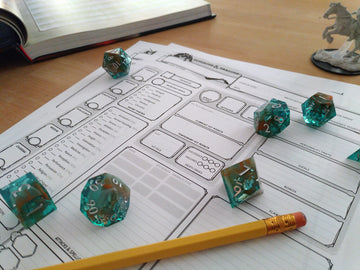


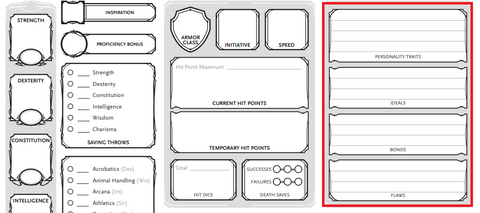










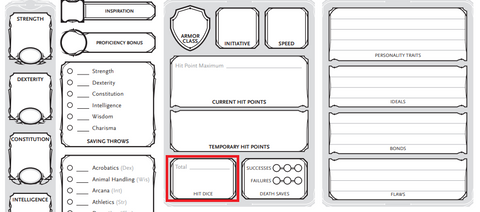

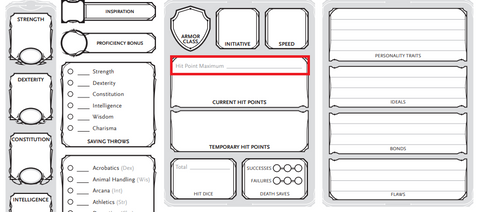










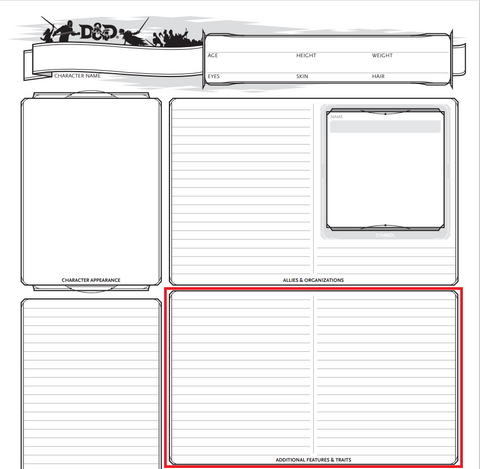





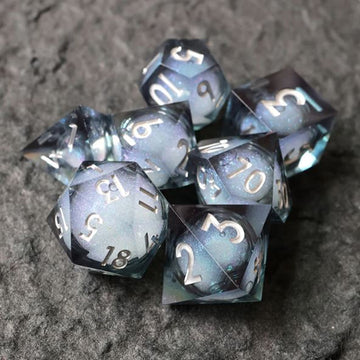
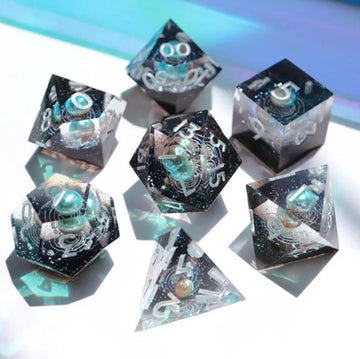
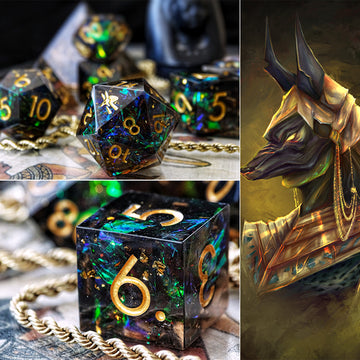
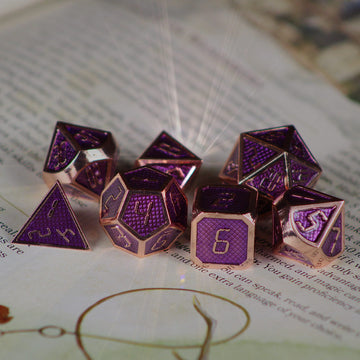
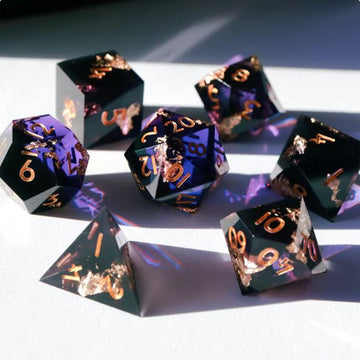
thank you for this super helpful, easy to read guide!!!
@JC I’m so glad to hear this blog was helpful! As of right now, we do not have a blog post on leveling up, but below I have typed up some of the most important basics. Do let me know if I’ve missed anything you were wondering about!
There is a section on your character sheet for recording your XP (it’s right beside the section for character alignment). XP in D&D works similarly to XP in video games: once you reach a certain amount, you gain a level (if you search “D&D character advancement,” you should find a table that displays all these numbers).
As you level up, you will get new abilities and spells. To identify which ones, you need only look at your class choice. The Players Handbook and many online resources have nifty tables that tell you exactly what abilities you’ll be getting and how many spells of what spell level you’re able to choose from.
You will notice that, at some levels, you receive what is called an “ability score improvement.” This simply means that you get an extra two points to place inside any Ability Score of your choosing. You can put both into one Score or put one point into two Scores. Remember that this will increase your Ability Score Modifiers, Saving Throws, and Skills, and may increase Initiative and AC. This blog can still act as a great guide for those increases!
The amount of Hit Dice you have will also increase. The amount is equal to your level. The type of Hit Dice you have will not change.
Finally, the moment you level up, you gain the opportunity to increase your HP Maximum. This is briefly touched on in the blog: “When your character levels up, you will roll one… Hit Die and add the number rolled to your Constitution Modifier. You then take this [new] number and add it to your current, total HP [Maximum].” This will give you your new HP Maximum.
Hit Dice are important for taking short rests. Rules as written, when you take short rests, you can roll anything from one to all of your Hit Dice (and add the number rolled to your Constitution Modifier) to regain HP. But remember: you don’t get the spent dice back until you long rest!
I hope this was helpful! Please do let me know if there’s anything else you’d like to know.
Thank you for making an honest to goodness step-by-step that makes total sense.